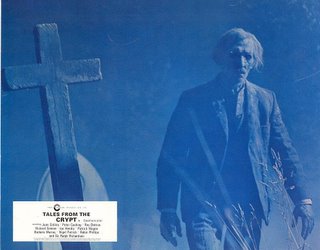 A colour publicity still for the black-and-white film,
A colour publicity still for the black-and-white film,The Innocents
Here’s a farewell I’ve been dreading for years, the lovely Deborah Kerr has passed away. I was aware that she was unwell and liked to avoid the public eye, but had heard little else recently.
While many obituaries focus on her famous roll in the surf with Burt Lancaster in From Here to Eternity, and her dancing with Yul Brynner in family favourite The King and I, I’ll also remember her for the extraordinary performances in weirder movies, to be enjoyed down here in the Black Hole.
She could easily play a pillar of virtue, a beacon in the dark. In Powell and Pressburger's Black Narcissus (1947), where she has to wrestle with another nun’s failing faith as they are both tempted by sins of the flesh… There are many reasons that this sumptuous sixty year old film still plays today, and Kerr is definitely one of them.
Despite being typecast as the voice of reason, Deborah wasn’t afraid to play against type, notably her guardian in Jack Clayton's The Innocents (1961), whose wavering sanity threatens the very children she’s supposed to be caring for. It's another extraordinary role, so complex, that viewers are still unravelling whether the film is actually a ghost story, or a portrait of madness...
While many obituaries focus on her famous roll in the surf with Burt Lancaster in From Here to Eternity, and her dancing with Yul Brynner in family favourite The King and I, I’ll also remember her for the extraordinary performances in weirder movies, to be enjoyed down here in the Black Hole.
She could easily play a pillar of virtue, a beacon in the dark. In Powell and Pressburger's Black Narcissus (1947), where she has to wrestle with another nun’s failing faith as they are both tempted by sins of the flesh… There are many reasons that this sumptuous sixty year old film still plays today, and Kerr is definitely one of them.
Despite being typecast as the voice of reason, Deborah wasn’t afraid to play against type, notably her guardian in Jack Clayton's The Innocents (1961), whose wavering sanity threatens the very children she’s supposed to be caring for. It's another extraordinary role, so complex, that viewers are still unravelling whether the film is actually a ghost story, or a portrait of madness...

Another cult horror that is less remembered, is Eye of the Devil (1966). But it's thick with atmosphere, and watchable for the cast alone, that also includes Sharon Tate, David Niven and David Hemmings. The film's theme of satanism proved to be a premonition of Tate's ghastly fate...
Lastly, the crazy sixties psychedelic James Bond comedy with a huge budget. I always look forward to Deborah's segment in the first Casino Royale (1967), also playing against David Niven (as Sir James Bond). Her character has a Scottish accent, some lively physical comedy, and even sends herself up, as she again appears in a nun’s habit…
Beyond being a great actress, she helped create memorable characters that continue to intrigue and impress, long after the films are over.
Lastly, the crazy sixties psychedelic James Bond comedy with a huge budget. I always look forward to Deborah's segment in the first Casino Royale (1967), also playing against David Niven (as Sir James Bond). Her character has a Scottish accent, some lively physical comedy, and even sends herself up, as she again appears in a nun’s habit…
Beyond being a great actress, she helped create memorable characters that continue to intrigue and impress, long after the films are over.
- - - - - - -
































